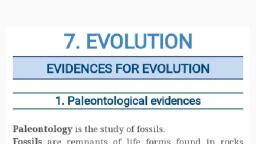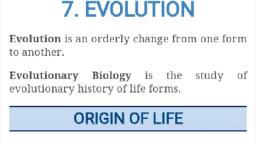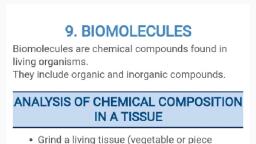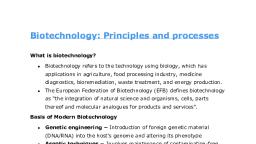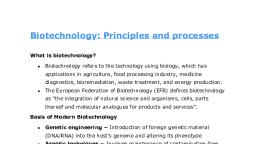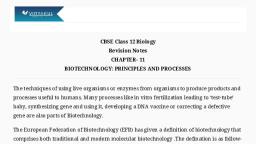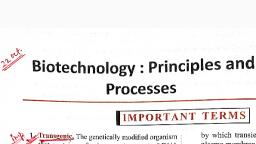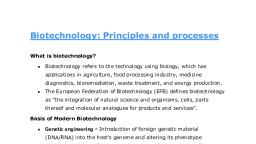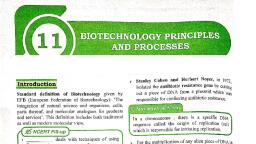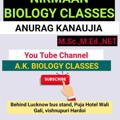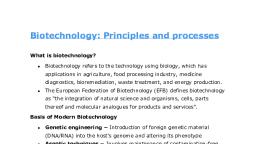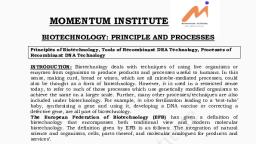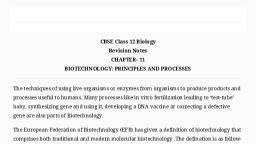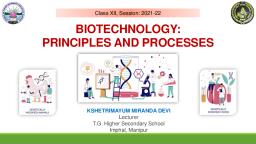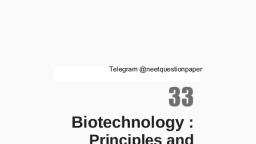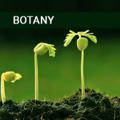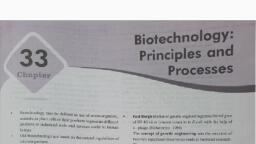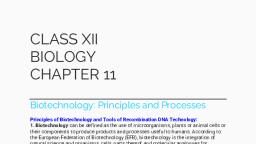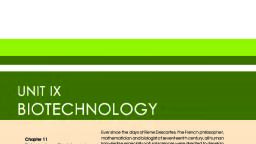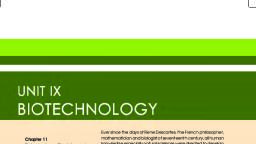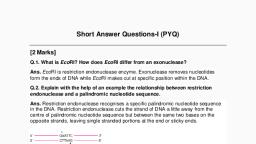Page 1 :
11. BIOTECHNOLOGY: PRINCIPLES, & PROCESSES, , - Biotechnology is the technique of using live, organisms or their enzymes for products &, processes useful to humans., , - The European Federation of Biotechnology (EFB), defines Biotechnology as ‘the integration of natural, science and organisms, cells, parts thereof; and, molecular analogues for products and services’., , Biotechnology deals with:, , Microbe-mediated processes (making curd, bread,, wine etc)., , In vitro fertilization (test-tube baby programme)., Synthesis and using of a gene., , Preparation of DNA vaccine., , Correcting a defective gene., , '
Page 2 :
PRINCIPLES OF, BIOTECHNOLOGY, , , , Core techniques of modern, biotechnology, , , , Genetic engineering: The technique in which, genetic material (DNA & RNA) is chemically altered, and introduced into host organisms to change the, phenotype., , Bioprocess engineering: Maintenance of sterile, ambience in chemical engineering processes for, growing desired microbe/eukaryotic cell for the, manufacture of antibiotics, vaccines, enzymes etc.
Page 3 :
Basic steps in genetically, modifying an organism, , , , a) Identification of DNA with desirable genes:, Traditional hybridisation leads to inclusion and, multiplication of undesirable genes along with, desired genes. In genetic engineering, only, desirable genes are introduced., , b) Introduction of the identified DNA into the host:, A vector DNA such as plasmid is used to deliver an, alien piece of DNA into the host organism., , c) Maintenance of introduced DNA in the host and, transfer of the DNA to its progeny: A piece of, alien DNA has no the sequence called Origin of, replication (ori) needed for starting replication. So,, it cannot multiply itself in the progeny cells of the, organism. Hence alien DNA is integrated into the, recipient genome (it has ori). It multiplies &, inherits along with host DNA., , - The process of joining and inserting a foreign piece, of DNA into a host organism to produce new, genetic combinations is called recombinant DNA, technology.
Page 4 :
: The process of joining and inserting a foreign piece, of DNA into a host organism to produce new, genetic combinations is called recombinant DNA, technology., , First recombinant DNA (rDNA) was produced by, Stanley Cohen & Herbert Boyer (1972)., They isolated an antibiotic resistance gene (piece of, DNA) from a plasmid of Salmonella typhimurium. It, was linked with a plasmid vector and transferred, into E. coli. As a result, the gene was expressed &, multiplied in F. coli.
Page 5 :
TOOLS OF RECOMBINANT DNA, TECHNOLOGY, , , , 1. Restriction Enzymes (‘molecular, scissors’), , , , - The enzymes that cut DNA at specific sites into, fragments., , - They belong to a class of enzymes called nucleases., , - In 1963, two enzymes responsible for restricting, growth of bacteriophage in E. coli were isolated. One, enzyme added methyl groups to DNA. The other, (restriction endonuclease) cut DNA., , - More than 900 restriction enzymes have been, isolated from over 230 strains of bacteria., , Naming of the restriction enzymes:, , - First letter indicates genus. The second two letters, indicate species of prokaryotic cell from which they, were isolated., , E.g. EcoRI comes from E. coli RY 13 (R = the strain., Roman numbers = the order in which the enzymes, were isolated from that strain of bacteria).
